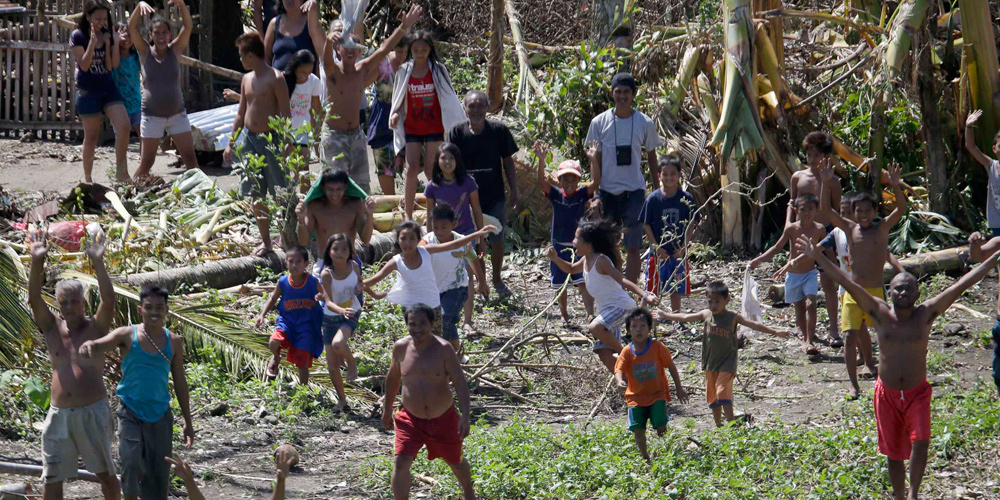French donors, Red Cross, Habitat come together for storm victims
DAANBANTAYAN, Cebu—At least 200 families that were displaced by Supertyphoon “Yolanda” (international name: Haiyan) woke up to brand new homes almost two years to the day the killer storm devastated the Visayas.
It was a day of gladness as well as sadness as residents remembered what happened when Yolanda hit land on Nov. 8, 2013, destroying their homes and livelihood.
Fernanda Cuyos recalled that before the onslaught of the typhoon, her family—including two of their grandchildren, aged 3 and 7—evacuated to the extension campus of Cebu Technological University (CTU).
“We were very scared. When Yolanda blew off the roof of the CTU gymnasium, we had to run to another building. After the typhoon passed, we checked our house and found that it was destroyed when two coconut trees fell on it,” said Cuyos.
Yolanda had made them anxious of typhoons, afraid that they might go through the same harrowing experience they had during the supertyphoon.
Article continues after this advertisementBut not anymore.
Article continues after this advertisementLast Friday, they were welcomed to their typhoon-resilient houses from the France-Philippines United Action (FP-UA) Foundation in Barangay Agujo and Paypay, Daanbantayan, 147 kilometers north of Cebu City.
The two housing projects cost $1.5 million and were financed by leading French companies.
One of the villages, the Habitat French Village, provides 76 disaster-resilient houses and a multipurpose center that were built on a 5,488-square meter property in Barangay Agujo that was donated by the Cebu provincial government.
The project was implemented in cooperation with the Habitat for Humanity Philippines.
The $500,000-funding for the French Village came from Republic Cement and Building Materials Inc. (formerly Lafarge), Schneider, Commanderie de Bordeaux, Megacem, Archetype, ParexGroup and ManilleBienvenue.
The Red Cross Village is composed of 128 houses built on 1.3 hectares in Barangay Paypay donated by Elaine Corro, sister of Daanbantayan Mayor Augustus Corro, under a usufruct agreement. This means the beneficiaries have full rights to use the property but could not dispose of it.
The $1-million Red Cross Village was funded by Total, Sanofi, Caisse des Depots and the French Red Cross. It was implemented in cooperation with the Philippine Red Cross and Habitat for Humanity Philippines.
Charlito Ayco, managing director and chief executive officer of Habitat for Humanity Philippines, recalled daring Filipino architect Ed Florentino to come up with a design that was disaster-resilient, considering that a major earthquake had hit Bohol and Cebu on Oct. 15, 2013, and less than a month later, Yolanda severely damaged the areas along its path.
Florentino used the hyperbolic paraboloid concept, which allows each house to withstand up to an intensity-8 earthquake and wind velocity of up to 275-km per hour.
Each house in the French Village has a floor area of 24 sqm and an allocation for a 10-sqm loft. The houses in the Red Cross Village have a floor area each of 30 sqm.
French Ambassador Thierry Mathou noted that the French Embassy organized the FP-UA to assist French private donors, nonprofit organizations and French agencies with their rehabilitation programs.
After Yolanda devastated central Philippines, then French Ambassador Gilles Garachon convened the representatives of leading French companies, the Conseiller du Commerce Exterieur and the French Chamber of Commerce to form the consortium.
Led by the French Chamber of Commerce, the FP-UA aimed to coordinate relief and rehabilitation projects initiated by the Filipino-French business community for the typhoon victims.
The consortium first focused on Daanbantayan, which was among the most affected areas by Yolanda.
Yolanda first made landfall at Guiuan, Eastern Samar, at 4:40 a.m. on Nov. 8, 2013, then at Tolosa, Leyte at 7 a.m. and then Daanbantayan at 9:40 a.m.
Mayor Corro said the FP-UA was among the earliest to visit Daanbantayan and provided continued assistance to the town.
The construction of the French Village began less than two months after Yolanda, and the Red Cross started in May 2014.
The facilities of the Red Cross Village include a barangay health station and a day care center, a livelihood center and a Red Cross room.
